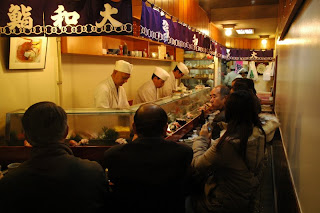 Perhaps Japan's most famous culinary exports are sushi (寿司 or 鮨), usually raw fish over vinegared rice, and sashimi (刺身), plain raw fish. These seemingly very simple dishes are in fact quite difficult to prepare properly: the fish must be extremely fresh, and apprentices spend years just learning how to make the vinegared rice for sushi correctly, before moving on to the arcane arts of selecting the very best fish at the market and removing every last bone from the fillets.
Perhaps Japan's most famous culinary exports are sushi (寿司 or 鮨), usually raw fish over vinegared rice, and sashimi (刺身), plain raw fish. These seemingly very simple dishes are in fact quite difficult to prepare properly: the fish must be extremely fresh, and apprentices spend years just learning how to make the vinegared rice for sushi correctly, before moving on to the arcane arts of selecting the very best fish at the market and removing every last bone from the fillets. There is enough arcane sushi terminology to fill entire books, but the most common types are:
nigiri (握り) - the canonical sushi form consisting of rice with fish pressed on top
maki (巻き) - fish and rice rolled up in nori seaweed and cut into bite-size chunks
temaki (手巻き) - fish and rice rolled up in a big cone of nori
gunkan (軍艦) - "battleship" sushi, like nigiri but with nori wrapped around the edge to contain the contents
chirashi (ちらし) - a large bowl of vinegared rice with seafood scattered on top
nigiri (握り) - the canonical sushi form consisting of rice with fish pressed on top
maki (巻き) - fish and rice rolled up in nori seaweed and cut into bite-size chunks
temaki (手巻き) - fish and rice rolled up in a big cone of nori
gunkan (軍艦) - "battleship" sushi, like nigiri but with nori wrapped around the edge to contain the contents
chirashi (ちらし) - a large bowl of vinegared rice with seafood scattered on top
 Nearly anything that swims or lurks in the sea can and has been turned into sushi, and most sushi restaurants keep a handy multilingual decoding key on hand or on the wall. A few species more or less guaranteed to feature in every restaurant are maguro (tuna), shake (salmon), ika (squid), tako (octopus), and tamago (egg). More exotic options include uni (sea urchin roe), toro (fatty tuna belly, very expensive) and shirako (fish sperm). Tuna belly comes in two different grades: ō-toro (大とろ), which is very fatty and very expensive, and chū-toro (中とろ), which is slightly cheaper and less fatty.
Nearly anything that swims or lurks in the sea can and has been turned into sushi, and most sushi restaurants keep a handy multilingual decoding key on hand or on the wall. A few species more or less guaranteed to feature in every restaurant are maguro (tuna), shake (salmon), ika (squid), tako (octopus), and tamago (egg). More exotic options include uni (sea urchin roe), toro (fatty tuna belly, very expensive) and shirako (fish sperm). Tuna belly comes in two different grades: ō-toro (大とろ), which is very fatty and very expensive, and chū-toro (中とろ), which is slightly cheaper and less fatty.If you somehow ended up in a sushi restaurant, but can't or don't want to eat raw fish, there are usually several alternatives. For instance the above mentioned tamago, various vegetables on rice, or the very tasty inari (rice in a sweet wrap of deep fried tofu). Or order the kappa maki which is nothing more than sliced cucumber, rolled up in rice and wrapped in nori.
Even in Japan, sushi is a bit of a delicacy and the most expensive restaurants, where you order piece by piece from a chef, can run you bills into tens of thousands of yen. You can limit the damage by ordering a fixed-price moriawase (盛り合わせ) set, where the chef will choose whatever he thinks is good that day. Cheaper yet are the ubiquitous kaiten (回転, lit. "revolving") sushi shops, where you sit by a conveyor belt and grab whatever strikes your fancy, at prices that can be as low as ¥100 per plate. Even in these cheaper places, it's still quite acceptable to order directly from the chef. While in some areas like Hokkaido, kaiten sushi is of consistently good quality, in larger cities (especially Tokyo and Kyoto) the quality varies considerably from place to place with the low end restaurants serving little more than junk-food.
When eating sushi, it's perfectly acceptable to use your fingers; just dip the piece in soy and pop it in your mouth. In Japan, the pieces typically have a dab of fiery wasabi radish already lurking inside, but you can always add more according to your taste. Slices of pickled ginger (gari) refresh the palate and infinite refills of green tea are always available for free.
Despite fish sashimi being the most well known, there is no shortage of other types of sashimi for the adventurous ones. Hokkaido crab sashimi and lobster sashimi are considered delicacies and are definitely worth a try. Whale (yes, the sea mammal) is also available though many Westerners prefer to avoid it due to the controversies surrounding current whaling practises. For the most adventurous type, a very unconventional type of sashimi available is horse meat sashimi.
No comments:
Post a Comment